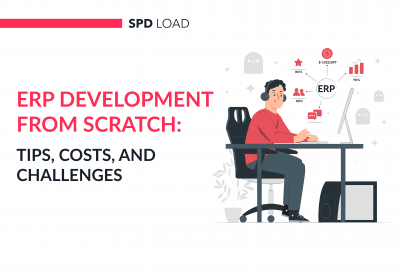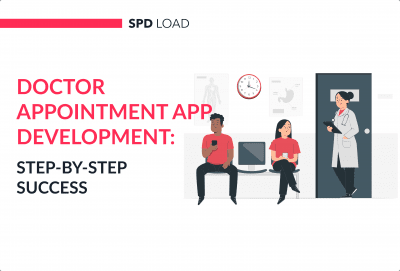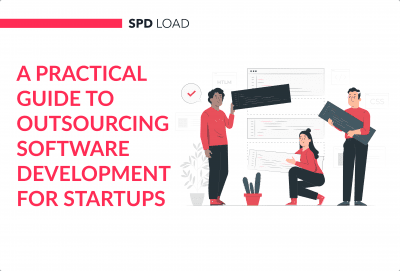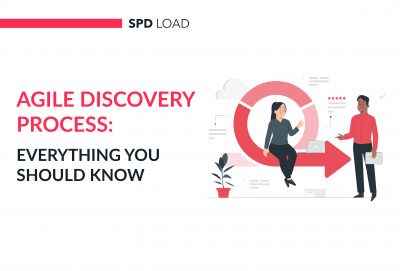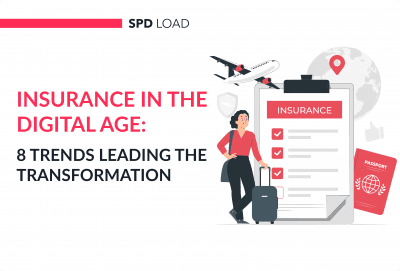HRMS Software Development: A Step-by-Step Guide
- Updated: Nov 07, 2024
- 11 min
What does it cost to develop a custom human resources management system?
This guide tackles key questions like:
- What are the current market conditions for launching an HRIS startup?
- How can I develop my own HR application from the ground up?
- What does the development process entail?
- Is building an HR management solution in-house or using an external team more cost-effective?
- How do I find the right development partner?
We’ll also explore the main HR solution features and estimate development costs in different countries.
If you prefer graphics over text, skip ahead to the bonus infographic.
Entering the SaaS world? Check out these best SaaS startup ideas are worth exploring.
Let’s dive in!
Bring your app idea to life with our expert software developers — contact us today to get started!
Why Now is the Perfect Time to Launch an HRMS Startup
Two key factors make launching an HR startup in 2025 a good idea.
On the one hand, the trend towards globalization showed that remote is the future of any business, especially in the field of IT and software development.
We can take a look at these processes and HR functions as an example:
- Company’s performance management
- Employee performance tracking and payroll management via payroll software
- Remote hiring process and talent management
On the other hand, the pandemic changed the way people work. The massive shift to the remote work model placed a significant demand on HR startups. How do we know?
- Ravish Agrawal, CEO at Able Jobs, revealed that less than 15% of their entry-level interviews with customers were online before the pandemic, but now it’s more than 75%.
- Regarding the digital touchpoint, less than 20% of companies used it before COVID, while now it’s more than 60%.
- HR departments started to aim at employee retention, which increased the need for employee engagement.
- According to Unleash, Global HR technology investments had deals of $100 million or more at the end of 2020 – one of the highest levels since 2017.
- According to PwC’s HR Technology Survey, in 2020, there were $148 billion of investments in HR solutions.
Now, let’s take a look at the details of the development process.
How to Build HR Management Software from the Ground Up
The first thing you should remember about human capital management system design and development is that it requires time, effort, and money.
After all, you can consider this software like real estate – your private property. And you are in charge of its construction and arrangements.
But unlike real estate, investment in a startup can pay off a hundredfold in a short time. So it is better to take enough time to create a high-end product that your customers will love.
That’s why it is crucial to think through all the details, starting from the business analysis, design, software development, and testing stages.
The Discovery Phase
Among the various stages of software development for the HR team department, the project discovery process is fundamental.
The team identifies and analyzes requirements and business goals to propose a technical implementation, set project timelines, and estimate development costs.
As a founder, you should start by identifying your target audience and analyzing your competitors.
The goal here is to think through the concept of your own “betterness” instead of existing solutions.
And it is not only about other digital platforms but also about other non-digital ways to solve the same problem.
We have prepared a list of questions to help you in the research phase:
- Who is the primary target audience?
- What is the biggest problem the customer currently has?
- What have they done in the past to resolve this problem, what went well, and what do they want to change?
- What have they paid in the past to solve this problem?
- What is the ideal outcome they want to experience if the problem were perfectly solved?
If you’re looking for strategies to boost your remote team’s performance, check out this guide on high-performance remote teams.
The discovery phase involves several steps. Let’s take a closer look at each one.
1. Define What Type of HR HRMS Platform You Want to Build
Moreover, the vision, of course, determines the complexity of the future human resource management system.
The complexity of the platform directly determines the final cost of the development of your custom HR web or mobile application.
Among other options, evaluate the following software development opportunities:
- Recruiting-focused
- Onboarding-focused
- Performance-focused
- Talent-focused
- Employee training-focused software
- Administrative-focused
- Workforce management-focused
- Employee management-focused
- Benefits administration-focused
As for examples of the recruiting-focused software, we can mention such companies as:
- Yello, which provides employee referrals, schedule automation, video interviewing features;
- Beamery, a British startup that is among the ten fastest-growing companies in the UK and specializes in self-styled recruitment marketing software for fast-growing companies; For companies looking to streamline hiring, choosing the best recruitment CRM can make all the difference in talent acquisition.
- Avature, a platform for Global Talent Acquisition with more than 650 customers.
- FactoHR, an automated hire to retire solution, helps to find the most skillful talent by incorporating the use of all the types of hiring approaches, resume parsing, smart duplication detection, and applicant tracking functionalities. In fact, for companies scaling quickly, implementing an applicant tracking system can make all the difference.
2. Prepare Requirements Documentation
Creating documentation is an essential step because the textual description of the project determines how it will work.
The purpose of the documentation phase is to prepare quality business and technical requirements. The technical ones include the design and the code requirements.
Based on the requirements file, the team will define what and how they have to build. And this will be a base for future estimations.
There are several ways to work with documentation. On the one hand, you can try to create the requirements yourself.
And on the other hand, what happens much more often, the team in cooperation with you will make the requirements.
The second option will be more development-friendly and streamline the creation of software solutions. 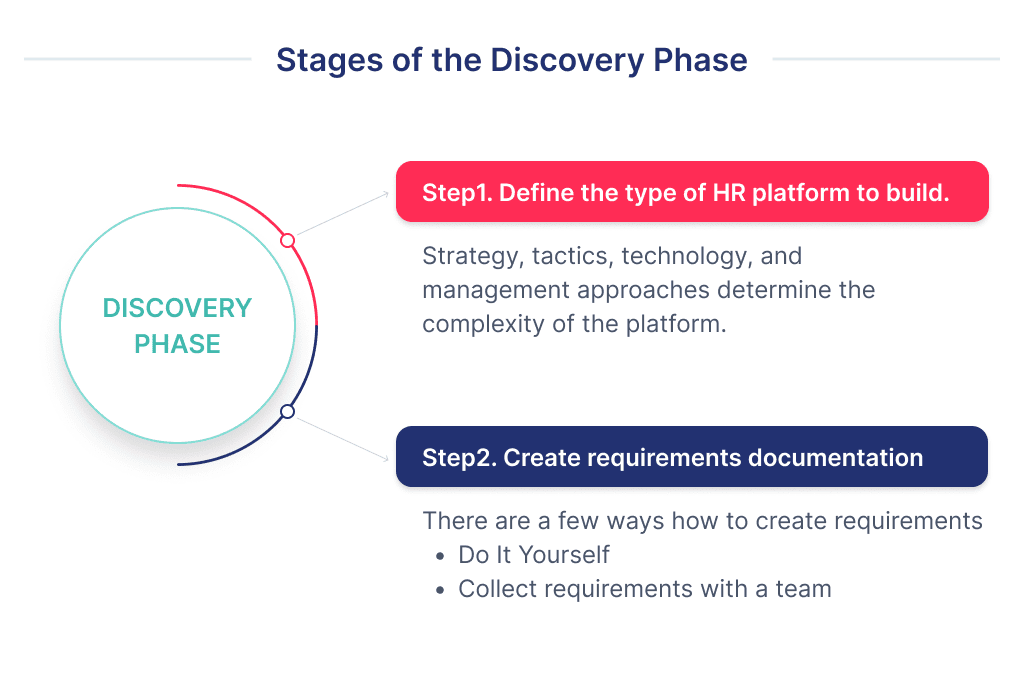
3. Define Tech Stack
The technology stack is a set of development tools, languages, and frameworks. It directly affects the user experience and overall performance of your future SaaS platform.
If you’re deciding between software models, this comparison of the ASP model vs SaaS model can help you choose.
The choice of development technologies depends on the requirements documentation. There are a few things to understand.
There is the server-side, the backend, invisible to the end-user, where data processing occurs. And the client-side, the frontend, where the user interacts with the application interface in real-time.
The choice of development language depends entirely on the business goals. For startups, for example, rapid growth and scaling are critical.
But other companies have other goals. Some even work with legacy languages, so-called legacy code.
Struggling to pick technologies for your project? Discover how to choose a tech stack with our expert advice.
4. UX Design of a custom HRMS
The UX design visualizes the first workflow of how your future application will work. It is based on the mix of your vision, user research, and documentation.
The more detailed preparatory work you and your team do, the more valuable the business logic of the future product will be in the output.
The UX designer’s tasks in this stage include:
- User journey. This step is about planning the screens that the users will need to achieve their goal.
- Layout and arrangement of information. This step is about building a flowchart or mindmap (site map or application).
- Low-fidelity wireframes. Creating very rough drafts of the interface
- High-fidelity prototypes. Elaboration of more detailed, with a grid and typography, but still black-and-white drafts of interface functionality and making it clickable.
In this way, users get an application where everything is laid out while customers receive a product that can be rapidly developed.
After the discovery phase, the development phase begins. 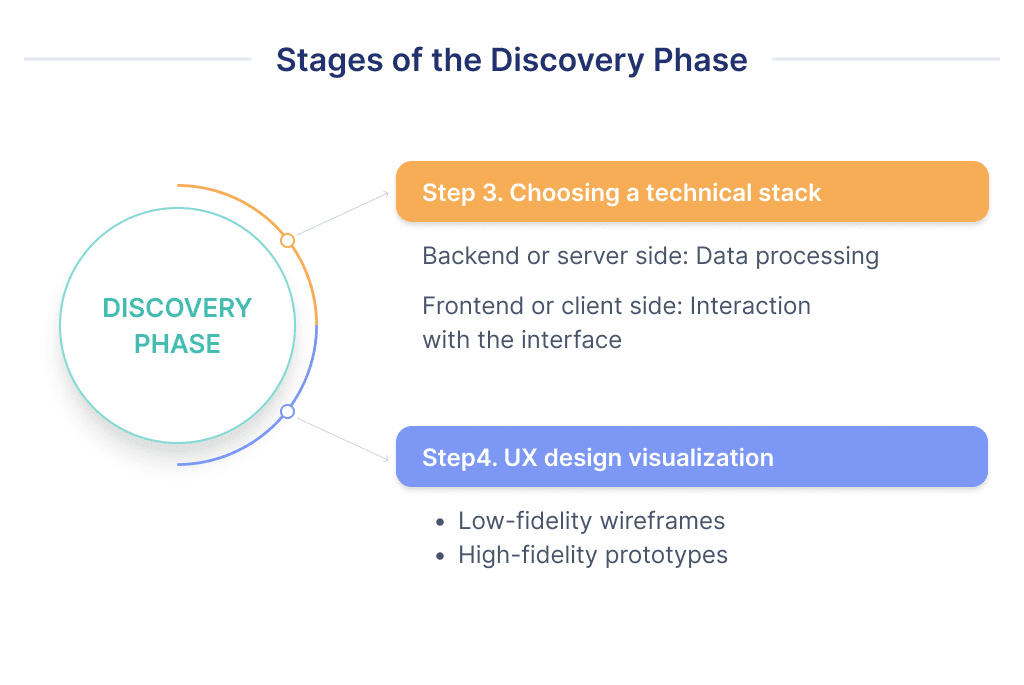
The Development and Testing Stage
The development of your custom HR system begins with the Minimum Viable Product. MVP in software development is a common approach in startup development.
In a nutshell, it is the development of the core HR features of your project to test the viability of your idea or business model. An MVP consists of a minimal set of hypotheses to test.
Meanwhile, the product could contain a few MVPs or a few core features that deliver complex value to the final user.
We would like to share an actual case study on the proper use of MVP in product development.
A few years back, we developed HR software for Blue Academy. It’s a Germany-based HR startup.
Then we faced the classic task of MVP development service: to test the idea’s viability quickly in the real market.
Together with the founders, we went all the way from creating documentation and development of the MVP to the fundraising of investment round A.
If you’re interested in finding out more details, feel free to check the case study.
Meanwhile, let’s get back to the core features you need to include in the MVP development phase of the HR application.
Features for an MVP
The point is that the complexity and riskiness of the vital business hypothesis determine the set and complexity of the MVP features.
And this affects the timing and speed of development.
In this case, we’ll take the functions from our experience as a basis.
Among the features that are primary key for successful HR system development are:
| Features | Description |
| Implementation of a role system | It is creating a system of roles for HR platform management. It is important to lay this down at the documentation design stage. For example, there could be roles of HR manager, employee, recruiter, and applicant. |
| Sign up and sign in | The usual login and the moment when the user creates a profile. |
| Creation and editing of a profile | Creating, storing, and editing employee data or manager profiles. |
| User onboarding | It introduces prompts and highlights the following steps to make employee self-service as easy as possible for the user to enter the app. |
| Employee’s performance review and improvements tracking | Key functionality to be developed in HR web or mobile application. The complexity and nuances of execution depend on your idea. Typically, this feature means setting metrics and development plans and the ability to track progress. |
| Payment gateway | This integration is about connecting a payment system like PayPal or Stripe so that users regularly pay for the use of your product accordingly to your pricing plans. |
| Notifications | Customizable notifications about new events. A handy feature for user retention. This churn rate calculator is a useful tool for SaaS businesses aiming to maintain a stable customer base. |
| Legal compliance | In addition to standard encryption, you may need to implement additional data protection protocols, such as GDPR, to develop your HR platform. Also, it helps to make sure about the security of employee information. |
But sometimes, founders lay down more advanced functionality for MVPs or focus on scaling shortly.
Consider this option as well.
Check out how we approach MVP development
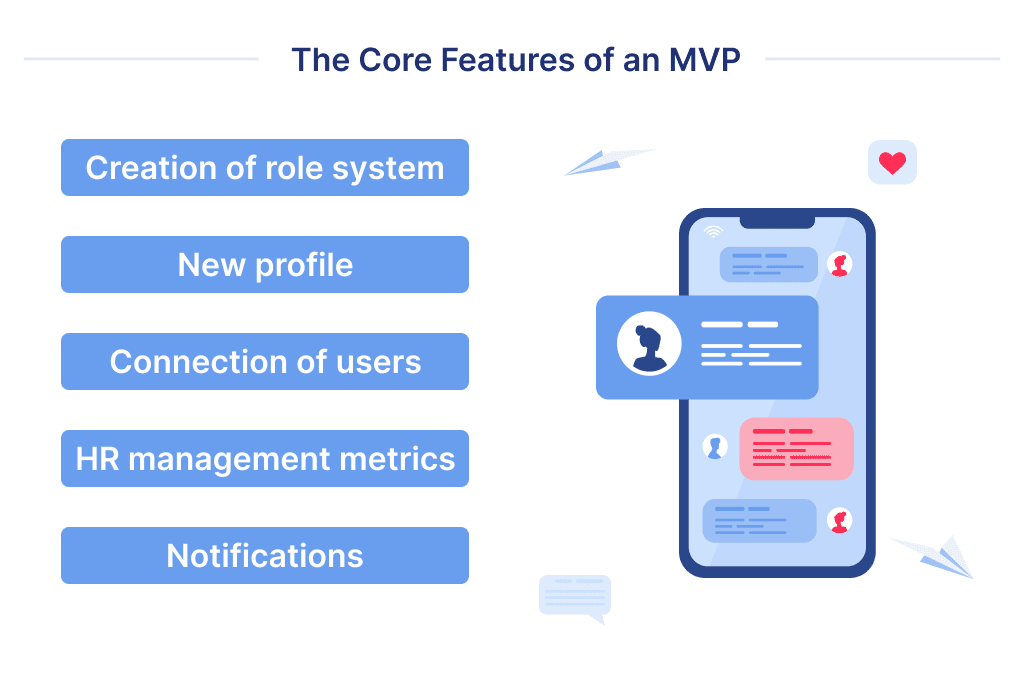
Features for Scaling an MVP
There are also features that you can add for the extended functions of your HR system development to increase user’s engagement and deliver more value, such as:
| Features | Description |
| Social sign in | Logging in through social networks allows for a smoother user experience and makes it easier to create a profile. |
| Additional 3rd party integrations | The more integration – the more sophisticated, valuable, and high-quality experiences your users will have. Naturally, the set of tools depends on the business objectives, which is why this point is so fuzzy. But as an example, integration with DocuSign, Slack, or Dropbox. |
| Integration with LMS | Allows you to maintain remote learning, online training, and workshops. |
| Benefits management | This feature provides full information on employment benefits and incentives available to employees. |
| Implementing ML or AI algorithms | AI software can automate the workload and boost the efficiency of HR software solutions. For example, it can perform a preliminary analysis of a candidate’s resume to check their skills and eliminate human bias. AI can be a complex field, but understanding the basics is easier with our comprehensive AI glossary. |
As you may have realized, the design and development of your human resource management platform are limited only by budget, not by technical limitations.
You can implement anything you want.
But the quality of implementation is the next important issue we would like to discuss. And the answer to this question lies in the choice of the dedicated development team. 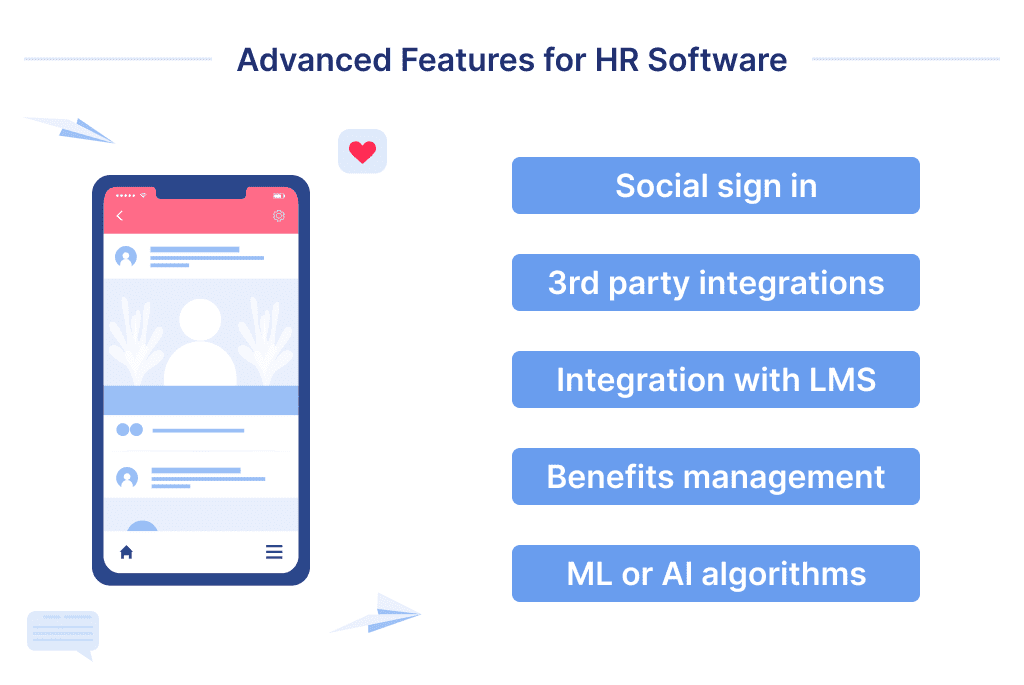
How to Find a Reliable Technical Partner
Only the right choice of an app development partner will help achieve your goals and ensure the development of a professional HR platform and contribute to its effectiveness.
At this stage, the client needs to consider the information obtained from prior analysis carefully.
Then, create a list of several partners who meet the preliminary requirements: good price segment, expertise needed to solve the task, etc.
The ready HR platform should not only have an eye-catching design but must provide a return on investment.
So, for choosing a development partner, we suggest you consider the following:
- Development of rapid time-to-market products;
- Sufficient number of quality use cases/scenarios in the portfolio;
- Positive feedback (recommendations) from previous clients;
- A decent level of documentation (commercial proposal, terms of reference, contract);
- Prompt response to the clients’ requests.
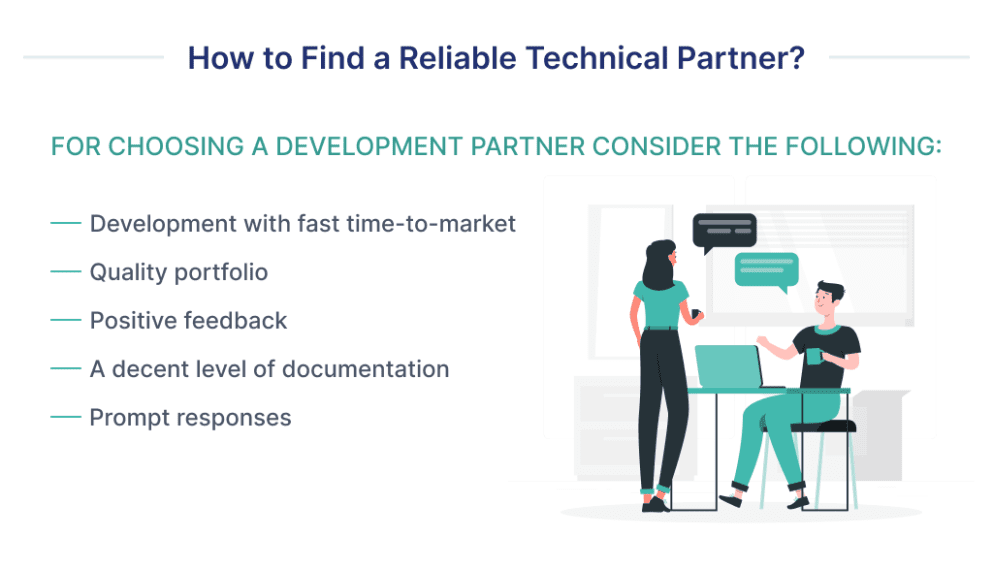
How Much Does the HR Software Development Cost?
Based on the features we talked about earlier, we made a rough estimate of creating an HR platform in different teams.
For the estimation, we use an hourly rate.
It would take 640 hours to develop an MVP and 960 hours for a large-scale MVP.
| Country | Rate (hourly) | Cost of an MVP | Cost of a scaled MVP |
| The USA | $150 | $96,000 | $144,000 |
| Great Britain | $100 | $64,000 | $96,000 |
| Ukraine | $40 | $25,600 | $38,400 |
| India | $25 | $16,000 | $24,000 |
Each case is unique, and several factors could influence the average cost of HR software development:
- Project’s complexity and technology stack;
- The team size required for the project;
- Average hourly rate;
- The time frame for the project.
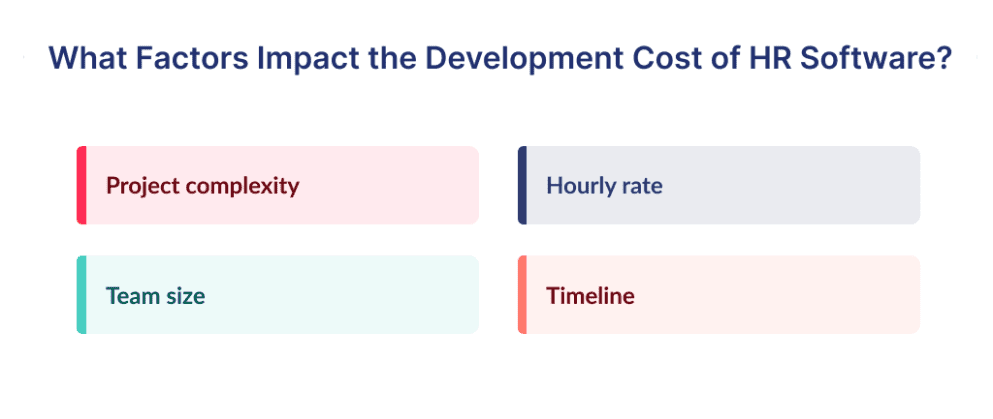
In this article, we break down the cost to build your own HR software, from essential features to advanced integrations.
Looking for inspiration for your HR software? Feel free to explore the best HR software solutions on the market.
The Checklist to Get a Proven Estimation
Usually, you can determine the estimated costs involved after the following:
- The customer contacts the software development partners
- The partners collect the data needed for further analysis.
- The specialists determine the requirements for the product.
- The team makes a document for an estimation, which the client must approve.
- The team begins to develop a solution and make changes if necessary.
- The customer receives the ready MVP.
- The team begins to evaluate the cost of the software.
- When the software valuation is ready and every stakeholder has agreed on it, it’s time to proceed to the development stage with an accurate assessment, technology, and team.
If you are given an estimate for project development without specifying requirements, you are most likely dealing with an incompetent team.
Even the most experienced HR platform developers specify requirements.
What’s Next?
Implementing a custom HRMS takes careful planning, stakeholder collaboration, and technical expertise.
Does your organization need an HRMS overhaul or custom solution? Our software engineers have decades of experience building HR platforms that streamline operations and provide analytics around pay, time-tracking, onboarding, and more.
Our journey to becoming a Clutch Leader in Ukraine shows how we put client success at the heart of everything we do.
We utilize the latest technologies to create solutions aligned with your specific organizational processes and objectives across web and mobile apps.
Contact us today for a free consultation on developing a high-performance HR management system uniquely tailored to your needs, budget, and timeline.
Budgeting for an app? Our article on app development costs gives you the insights you need to plan your project smartly.
Bonus Infographic
Here you’ll find a summary of our in-depth guide. Everything you need to know and follow to launch a successful HR startup in 2023 or beyond. 





